C.ダーウィンの日記(1836年9月4日) [ダーウィンが行く(後半)]

C.ダーウィンの日記(大西洋; ベルデ岬諸島を後にして、北回帰線を越える)
[日記訳]
(1836年9月)4日[1831年12月27日に英国プリマスを出発してから4年8ヶ月と8日後]
4日の夕刻、夕闇の中に消えてゆくサンティアゴ[注]の不規則な山々に別れを告げる事を私たちはみんなとても喜んだ。正直に言うが私はこの島にはなんらかの好意を感じている。そうでなかったら恩知らずであるだろう。私は初めてある溶岩の洞窟内に立ち大西洋のうねりがでこぼこの岸に打ち寄せるのを見ていた時の喜びを決して忘れないだろう。
[注] ベルデ岬諸島。
9日
北回帰線を超えた[注]。
[注] C.ダーウィンの乗ったビーグル号が航海を開始して、北回帰線を南に越えて熱帯に入ったのはこの4年7ヶ月と30日前(日付変更があるので実感としては29日)前の1832年1月10日のこと。その時の日記については下記のブログ・アーカイヴ記事参照:
http://saltyfumi.blog.so-net.ne.jp/1832-01-07
[地図] 1836年9月9日午前10時のビーグル号の位置(Capt. R.FitzRoy; 図右下にベルデ岬諸島)..
View Larger Map
[天候: Capt.R.FitzRoy]
1836年9月4日午前9時の天候:
北東の風、風力5、青空、雲、スコール、気温摂氏26.1度。
9日午前10時の天候:
変わりやすい風、風力5、青空、雲、スコール、驟雨、気温摂氏22.8度、水温摂氏24.4度。
[日記原文]
4th
We were all very glad in the evening of the 4th to wish farewell to the irregular mountains of St Jago, as they disappeared in the evening shades. I confess, I feel some good will to the Island; I should be ungrateful if it was otherwise; for I shall never forget the delight of first standing in a certain lava cavern & looking at the swell of the Atlantic lashing the rugged shores. —
9th
Crossed the Tropic of Cancer.

ここで扱うのは私の以前書いていたブログ "ダーウィンの日記(III)"
[特に http://saltyvoyage.blog.so-net.ne.jp/1836-09-04 以降]
からの再録になります。ただし、訳文や付加する地図などに対して、改良を加えてます。
C.ダーウィンの日記(1836年8月31日から9月4日) [ダーウィンが行く(後半)]
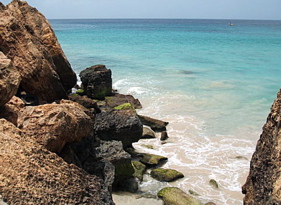
C.ダーウィンの日記(大西洋; ベルデ岬諸島, サンティアゴ島のプラヤ港[地球一周からの帰途における再訪])
[日記訳]
(1836年8月)31日 - 9月4日
とても素晴らしい海上移動を経て朝早くプラヤ港[注]の投錨地に来た。よくある事だがここに何隻かの奴隷船がいた[*注]。
[注] ベルデ岬諸島、サンティアゴ島の南端部にある港。C.ダーウィンはこの4年と約7ヶ月前、ビーグル号に乗って間もない1832年1月16日から2月8日まで、ここに滞在した。
[*注] 1832年1月24日付の日記参照..
http://saltyfumi.blog.so-net.ne.jp/1832-01-24 (アーカイヴ記事)
4日間という短い滞在の間天候はとても良かったが、これは健康に良くない時節のはじまりであったので、私は短い散歩をするにとどめた。
この地について述べる事は何もない。いくらか雨が降っていたので、ほんのかすかな緑の色合いがようやく見分けられた。 私たちの旧友であるバオバブの大木[注]は濃い緑の葉のをまとい、そのため外観がだいぶ変わっていた。
[注] 1832年1月20日および24日の日記参照:
http://saltyfumi.blog.so-net.ne.jp/1832-01-20
http://saltyfumi.blog.so-net.ne.jp/1832-01-24
予期された事ではあろうが、サンティアゴの先の訪門の時ほどは私は感激しなかった。だが、今回でも、その自然史には興味深いものを多く見出した。
はじめて砂漠の火山性平原(イングランドにおける何ものとも全く異なる種類の土地であるが)を眺めたり、燃えるように輝く気候の中へ入る際に受ける最初の感動といったものが、もし自然の外観を見る事に楽しみを抱く者の心に最も生き生きとした印象を与えなかったとしたなら、それはむしろ奇妙な事であろう。
[地図]
サンティアゴ島(ベルデ岬諸島)のプラヤ..
View Larger Map
[天候: Capt.R.FitzRoy]
1836年8月31日午前9時の天候:
北東の風、風力4、青空、雲、スコール、水温摂氏25度。
1832年、C.ダーウィンがサンティアゴ島のプラヤに到着してはじめて上陸した時の日記(1832年2月16日付け)を含むブログ・アーカイヴ記事..
http://saltyfumi.blog.so-net.ne.jp/1832-01-12
[日記原文]
31st —September 4th After a most excellent passage, we came to an anchor early in the morning at Porto Praya. We found lying there, as commonly is the case, some Slaving vessels. The weather, during our short stay of four days was very fine, but as this was the beginning of the unhealthy season, I confined my walks to short distances.
I have nothing to say about the place; as some rain had fallen, a most faint tinge of green was just distinguishable. Our old friend the great Baobab tree was clothed with a thick green foilage, which much altered its appearance.
As might be expected, I was not so much delighted with St Jago, as during our former visit; but even this time I found much in its Natural History very interesting. It would indeed be strange if the first view of desert volcanic plains, (a kind of country so utterly different from anything in England) and the first sensations on entering an ardent climate, did not excite the most vivid impressions in the mind of every one, who takes pleasure in beholding the face of nature.

ここで扱うのは私の以前書いていたブログ "ダーウィンの日記(III)"
[特に http://saltyvoyage.blog.so-net.ne.jp/1836-08-31 以降]
からの再録になります。ただし、訳文や付加する地図などに対して、改良を加えてます。
冒頭画像出典 http://www.panoramio.com/photo/856152
C.ダーウィンの日記(1836年8月17日から21日) [ダーウィンが行く(後半)]

C.ダーウィンの日記(ブラジル・ペルナンブコを出発して大西洋を北に進む[この後ベルデ岬諸島の中のサンティアゴを経てアゾレス諸島へ])
[日記訳]
(1836年8月)17日
私は17日に乗船してその午後ブラジルの海岸を離れた事を喜んだ。船首を風上に向けていて[注]、そのためかなりの縦揺れがある。私はかなり船酔いに苦しんでいる。だが、英国への帰途である。実のところ、このような時間、健康、安楽の損失や喪失という苦しみに耐えるにはそのような慰めが必要なのだ。
[注] この前後、東寄りの風。下の天候欄[Capt. R.FitzRoy]参照。
21日
赤道を超えた[注]。
[注] 下の地図参照。
[地図] 1836年8月21日午前10時のビーグル号の位置(Capt. R.FitzRoyによる)
View Larger Map
[天候: Capt. R.FitzRoy]
1836年8月
17日午前10時の天候:
南東の風、風力4、青空に雲、暗い、気温24.4度、水温24.4度。
18日午前10時の天候:
東の風、風力5、青空に雲、スコール、気温25度、水温24.7度。
21日午前10時の天候と位置:
南東の風、風力4、青空に雲、気温摂氏23.9度、水温摂氏24.4度;
北緯0度15分、西経30度41分。
[日記原文]
17th I was delighted on the 17th to get on board the ship & in the afternoon to leave the shores of Brazil. We lie close hauled to the wind, & therefore there is a considerable pitching motion; I suffer very much from sea-sickness. — But it is on the road to England; in truth some such comfort is necessary to support the tedious misery of loss of time, health & comfort. —
21st We crossed the Equator. —

ここで扱うのは私の以前書いていたブログ "ダーウィンの日記(III)"
[特に http://saltyvoyage.blog.so-net.ne.jp/1836-01-12 以降]
からの再録になります。ただし、訳文や付加する地図などに対して、改良を加えてます。
[日記原典] Charles Darwin's Beagle Diary ed. by R.D.Keynes, Cambridge U.P., 1988.
C.ダーウィンの日記(1836年8月6日から12日) [ダーウィンが行く(後半)]
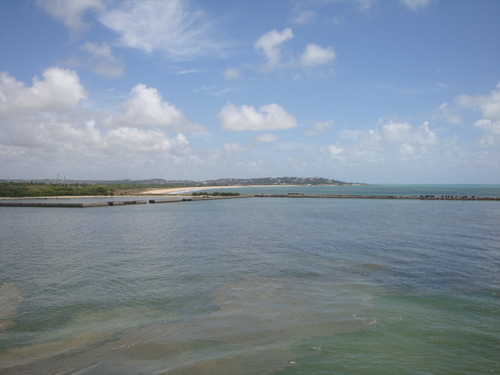
ペルナンブコ(レシフェ)の入り江からオリンダの町方向
C.ダーウィンの日記(ブラジル; ペルナンブコ)
[日記訳]
(1836年8月)6日
午後、抜錨して外洋に出た[注]。
[注] もとの停泊地はブラジル東部バイアのサルバドルの港。
12日
天気が悪くて、進路を変えてぺルナンブコ[注]に向かった。[入り江の]中には入らずに投錨したのだが、やがて水先案内が船上に来て入り江の内側に導き入れた。ここは町に近い。
[注] 現在のレシフェ。 下の地図参照。
ペルナンブコは海水の浅い水路で互いに隔てられたいくつかの狭く低い砂の堤の上に建設されている。この町の3つの部分が木製の杭の上に建てられた2本の長い橋で連結されている。町の至る所はうんざりさせるもので、通りは狭く、舗装は悪く、不潔で、家屋はかなり背が高くて陰鬱である。通りにおいて朝出会う白人の数は他の国での外国人の割合ほどである。他の全ての人々は黒人であるか浅黒い色をしている。後者もブラジル人[注]もその容貌において魅力的とは言いがたい。貧しい黒人は、どこにいようと、陽気で話し好きでにぎやかである。
[注] 単にブラジル人と云った場合、C.ダーウィンは主としてポルトガル系のブラジル人を意味している。
この大きな町のなかには、見るもの、匂い、音で何らかの楽しい印象を与えるものは何もなかった。大雨の降る季節がまだ終わろうとせず、海面すれすれの高さのこの周囲の地帯は水浸しとなっていた。私はどうにも長い散歩をすることが出来なかった。しかし、郊外の邸宅の多くはバイアのものに似ていて熱帯の植生の繁茂する特徴と良く調和する華美な外見を持つことを観察することは出来た。
この平坦で沼地の覆い土地は若干マイルの距離で低い丘、というよりも田野のおそらく海抜2百フィートの高さの縁といったものによって半円形上に取り囲まれている。 オリンダの古い町[注]はこの領域の一方の端にある。ある日私はカヌーによってそこを訪ねるために水路のひとつを進んだ。その位置から私にはこの古い町はペルナンブコよりも心地良くかつ清潔であることが分かった。
[注] ペルナンブコ(レシフェ)の入り江の北方に位置する。なお、冒頭画像参照。
ここ4年半の間のさすらいにおいて、どんな階層の人々の間においてさえも礼儀正しさが欠如しているということに私が出会った最初の時を、私は記憶せねばなるまい。つまり、私は2軒の相異なった屋敷において、この地の眺望を得る目的で耕作されていない丘に向かってその庭園を通り抜けることを不機嫌な物腰で拒絶され、ようやくの事で3軒目において許しを得たのである。私はこれが"善良な人々"[原文"Brava Gente"]の地で起きた事をとても喜ばしく感ずる。というのは私は彼等には何の善意も感じないからである。 スペイン人だったら、このような要求を拒絶するという考え自体を恥じたことであろうしまた誰かに対して無礼に行動する事を恥としたであろう。
私がオリンダに来てそして帰途についた水路は両岸をマングローブで縁どられていて、それらは脂っぽい泥の土手から小型の林のように生えている。これらの茂みの明るい緑色は常に教会の庭に生い茂った草を思い起こさせる。双方とも悪臭を発散するもので養われている。一方は過去の死を語り、他方はこれからのそれをよく物語る。
ペルナンブコの近傍で私が見た最も興味深いものは、入り江を形づくっているリーフである。これは幾マイルにもわたって完全に真っ直ぐにに延びていて岸からそう遠くなく平行になっている。その幅は30から60ヤードの間で変化がある。干潮の時にはすっかり乾いており水平で滑らかな表面を持っていて硬い砂岩の不明瞭な層から構成されている。だからはじめ見た時はこれが自然の産物であって人為ではないということをなかなか信じられない。 この有用性は多大なもので、内側の水域では近くでもかなりの水深があって、船は頂点にある穴に固定された古い大砲に係留されるのである。灯台が一方の端にあって、その周囲には波が強く砕けている。入り江に船が入る時、この地点の30ヤード以内のところを通りその砕け並みの泡のまっただ中を進むことになる。他方の端の近くには別の砕け波があるので、狭い通路を形成している。このような危険に船がまっしぐらに進むのを見るのは、そのように思われるわけなのであるが、ほとんどゾッとするようなことである。
このリーフの起源に関してであるが、私が思うに、現在の町がある低地が以前大きな湾によって占められていた時に水中にあった砂や砂利によって構成された砂州であろう。そしてこの砂州がはじめ固まってから隆起したのである。このふたつの別々の過程は南アメリカでかなり普通に起きている事であり、ゆえに私は今は以前に驚いたほどには意外には感じないのである。
もうひとつ、少し異なった説明も出来るのであり、これも同等の蓋然性を持っている。つまり、近傍にある海岸に今あるような砂地の長い陸地には結合した中心部分があったのが潮流の方向のわずかの変化により、遊離した部分が取り除かれて硬い核の部分だけが取り残されたのだということである。 外洋のうねりがリーフの狭く取るに足らない線に強く砕けるのであるが、その崩壊の証拠はない。この耐久性はその存在とも関連して最も興味深い事がらである。これは石灰質の層によるように思われる。それは主に、カンザシゴカイ[serpulae]、フジツボ[balani]、サンゴモ[corallinae]といった、ただし真のサンゴではない、いくつかの種類の有機体の漸次の成長によって形成されたものである。これは泥炭[peat]の形成とよく似た過程であり、それらの実体と同様、その効果はそこにある物質の劣化から守るのである。 真のサンゴ礁の場合は生きている密集体の最上端が太陽光線のために死んでそれらが取り囲まれてほぼ同様の過程によって保護されるわけである。プリマスにあるような防波堤[Breakwater]がこれら熱帯の海域に建築されたならそれは不滅であろう。云うところはつまり、陸地のどの部分とも同じく不滅であろうが、それら全てはやがては崩壊と修復を被らねばならないのであるが。
[地図] Pernambuco (Capt. R.FitzRoyによる緯度経度表示を地図上に緑色のマップポインターで示してある)..
View Larger Map
[天候: Capt.R.FitzRoy]
1836年8月12日午前10時の天候(南緯7度58分):
南東の風、風力4、全天曇り、雲、霧、暗い、スコール、驟雨、気温摂氏22.8度、水温摂氏24.4度。
[日記原文]
6th In the afternoon weighed anchor & stood out to sea. —
12th
The weather having been unfavourable, we altered course & ran for Pernambuco. We anchored outside; but in a short time a pilot came on board & took us into the inner harbor, where we lay close to the town.1
Pernambuco is built on some narrow, low, sand banks, which are separated from each other by shoal channels of salt water. The three parts of the town are connected together by two long bridges, built on wooden piles.The town is in all parts disgusting, the streets narrow, ill-paved, filthy, the houses very tall & gloomy. The number of white people, which during the morning may be met with in the streets, appears to be about in the proportion of foreigners in any other nation; all the rest are black or of a dusky colour. The latter as well as the Brazilians are far from prepossessing in their appearance: the poor negroes, wherever they may be, are cheerful, talkative & boisterous.
There was nothing in the sight, smell or sounds within this large town, which conveyed to me any pleasing impressions. The season of heavy rains scarcely had come to an end & hence the surrounding country, which is scarcely elevated about the level of the sea, was flooded with water. I failed in all my attempts to take any long walks. — I was however enabled to observe that many of the country houses in the outskirts were like those of Bahia, of a gay appearance which harmonized well with the luxuriant character of the tropical vegetation.
The flat swampy land is surrounded at the distance of a few miles by a semicircle of low hills, or rather by the edge of a country elevated perhaps two hundred feet above the sea. The old city of Olinda stands on one extremity of this range.
One day I took a canoe & proceeded up one of the channels to visit it; I found the old town from its situation both sweeter & cleaner than that of Pernambuco. — I must commemorate, as being the first time during the four & a half years we have been wandering about, that I met with a want of politeness amongst any class of people; I was refused in a sullen manner at two different houses, & obtained with difficulty from a third permission to pass through their gardens to an uncultivated hill for the purpose of taking a view of the country. I feel quite glad this happened in the land of the "Brava Gente"; for I bear them no good will. — A Spaniard would have been ashamed at the very thought of refusing such a request, or of behaving to any one with rudeness. —
The channel by which we came to & returned from Olinda is bordered on each side by Mangroves which spring like a miniature forest out of the greasy mud banks. the bright green color of these bushes always reminds me of the rank grass in a Church-yard: both are nourished by putrid exhalations; the one speaks of death past, the other too often of death to come. —
The most curious thing which I saw in the neighbourhood of Pernambuco, is the reef that forms the harbor. It runs for a length of several miles in a perfectly straight line, parallel to & not far distant from the shore; it varies in width from thirty to sixty yards; it is quite dry at low water, has a level smooth surface, & is composed of obscurely stratified hard sandstone: hence at the first sight it is difficult to credit that it is the work of nature & not of art. Its utility is great; close within the inner water, there is a good depth of water, & ships lie moored to old guns, which are fixed in holes on the summit. — A light-house stands on one extremity, & around it the sea breaks heavily. In entering the harbor, a ship passes within thirty yards round this point, & amidst the foam of the breakers; close by, on the other hand, are other breakers, which thus form a narrow gateway: it is almost fearful to behold a ship running, as it appears, headlong into such dangers.
With respect to the origin of the reef, I believe, a bar composed of sand & pebbles formerly existed beneath the water, when the low land on which the town now stands was occupied by a large bay; & that this bar was first consolidated, & then elevated. These two distinct processes are of so common occurrence in S. America, that I now feel none of that surprise, with which such facts would formerly have startled me.2 There is another & slightly different explanation, which possesses equal probability, namely that a long spit of sand like some that now exist on the neighbouring coast, had its central part consolidated, & then by a slight change in the set of currents the loose matter was removed, the hard nucleus alone remaining. Although the swell of the open ocean breaks heavily on the outer side of the narrow & insignificant line of reef, yet there is no record of its decay. This durability is the most curious circumstance connected with its existence: it appears to be owing to a layer of calcareous matter, formed by the successive growth of several kinds of organic bodies, chiefly serpulae, balani, corallinae, but no true corals. It is a process strictly analogous to the formation of peat, & like that substance, its effects are to preserve from degradations the matter on which it rests. — In true coral reefs, when the upper extremities of the living mass are killed by the rays of the sun, they become enveloped & protected by a nearly similar process. It is probable that if a Breakwater such as that of Plymouth, was built in these tropical seas, it would be imperishable, that is, as imperishable as any part of the solid land, which all, some day, must suffer decay & renovation.
1 Followed by a deleted sentence: 'On the ensuing day I took up my residence on shore in a Brazilian inn. —'
2 The sentence which follows was written on a separate unnumbered page, and marked to be inserted here.

ここで扱うのは私の以前書いていたブログ "ダーウィンの日記(III)"
[特に http://saltyvoyage.blog.so-net.ne.jp/1836-08-0ƒ6 以降]
からの再録になります。ただし、訳文や付加する地図などに対して、改良を加えてます。
冒頭画像出典: http://www.panoramio.com/photo/16971058
C.ダーウィンの日記(1836年8月1日) [ダーウィンが行く(後半)]
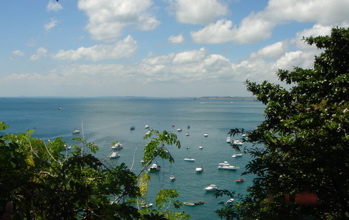
C.ダーウィンの日記(ブラジル; バイア)
[日記訳]
(1836年8月)1日
諸聖人の湾[注]に投錨した。この都市とその周囲のはじめに見た時の様相からは、私たちが以前にはとても喜ばしく思った美点とその魅力の一部が失われていた。新奇さと驚きが消え、さらには私らの記憶が長い期間の間にたぶん情景の色を誇張していたのだ。とはいっても、後に分かったのだが、よりもっともな理由があって、それはいくつかの最も見事なマンゴーの木が、先にあった黒人達の暴動の際に、伐られて失われていたということであった。
[注] 原文"Bahia de todos los Santos"。 Baía de Todos os Santos。ブラジル東部のバイアの湾で、その入り口にサルバドルの町がある。下の地図参照。
ここに4日間滞在したので、私は幾度もの長い散歩をした。熱帯の情景による私の楽しみが、新奇さの喪失によって少しの程度も減少していないことを見出して私は嬉しかった。 情景の要素はとても単純なので、精妙な自然美というのがどんな些細な状況に依存するものであるかの証明として言及する価値がある。ここは至る所で底の平たい谷が削り込まれている300フィートの高さの全く平らな平原であると叙述されよう。この構造は平地が通常構成される花崗岩地帯に顕著なのであるが、柔らかい地層の全てにおいてほぼ共通に見られる。地表全体が様々の種類の堂々とした樹木で覆われ、耕作地がちりばめられて、その中に家屋、修道院や礼拝堂がある。
熱帯においては自然の野生の豊穣は大都市の近郊においても失われないということは記憶さるべきである。生け垣や丘の脇の自然の植生は絵画的効果において人為を圧倒する。それだからほんのわずかの箇所の明るい赤土が全般的な緑の装いと強い対比をなすのである。平野の周辺部からは大洋あるいは巨大な湾の遠い瞥見があり、それらは低い樹々の海岸によって縁(ふち)どられ、その表層には無数のボートやカヌーがその白い帆を見せている。
これらの点を除いては見られる範囲はかなり限られていて、平らな歩道に沿うならば、両側に代わる代わる下方の森林の谷を覗き見ることがあるだけである。最後に付け加えねばならないことだが、家屋特に教会は特異かつ相当風変わりな建築の様式で建てられている。それらは全て白いしっくい塗りなので、真昼の輝く太陽に照らされているのを水平線からの青い空を背景に見ると、実際の建物というよりはまるで影のように立っているのである。
こうしたことが要素であるのだが、その効果を描こうとするのは勝ち目のない努力である。博学な自然史学者ならば、熱帯のこれらの情景を描写するにあたっていくつもの対象を挙げ、その何らかの特性的な特徴に言及することによって描くであろう。物知りの旅行者に対しては、こうしたことはなんらかのしっかりとした概念を伝えることが可能かもしれない。だが他の誰が植物標本集にある植物を見てそれが自生の土に生えている様(さま)を想像出来るであろうか? 誰が温室の精選された植物を見ていくつかを森の樹々の様相にまで拡大し、あるいは他をもつれあったかたまりに込み入らせることが出来るであろうか? 誰が飾り戸棚にある派手な蝶、あるいは風変わりなセミを調べていてこれらの対象を、後者のやむことのない耳障りな音楽に、または前者の物憂い飛翔に結び付けるであろうか。これらは熱帯の静かに輝ける昼にはかならず随伴するものである。太陽がその最大の高度を得るのはこの時であり、そのような光景が見られるものである。 それからマンゴーの密な素晴らしい葉がその真っ暗な影で地面を隠し、他方でその上部の枝は光のぜいたくによっていっそう輝くのである。 温帯では、そのように私には思われるのだが、事情は異なり、そちらでは色はそれほど濃くはなく、あるいは豊富ではなく、ゆえに傾きつつある太陽が、赤、紫または黄色の光線を投げかける時、その気候の情景に美を付け加えるに最もふさわしいのである。
日陰の歩道を静かに歩きながら次々と現われる眺望を賛嘆していると、人はその概念を表現する言葉を探す。相次いで形容語句が浮かぶが、どれもこうした感覚を経験する機会を持ったことのない人々に心の真の描像を伝えるには弱すぎることが分かる。温室の植物は植生の正当な概念を伝えることが出来ないと私は述べておいたが、再びそれを繰り返さなければならない。 陸地はひとつの大きな荒々しく、乱雑な、繁茂した温室であり、自然によるその見せ物小屋なのだが、人がそれを所有して派手な家屋や幾何学的配置庭園をちりばめたのである。 全ての自然賛美者の他の惑星を見たいという欲求は、もし可能であるとしてだが、どれほど強いものであろうか。だがその生まれ故郷の若干の緯度・経度の距離に他の世界の栄光がその者に開かれているということを真に言うことが出来るのである。
最後の散歩において、私は何度も何度もそのような美を凝視するために立ち止まり、印象を心に永遠に刻もうと努めた。その印象は遅かれ早かれ色あせるであろうとこの時私が知っていたのである。 オレンジの木、ココヤシ、シュロ、マンゴー、バナナ、こういったものの形状ははっきりそれぞれの形で保持されるであろうが、ひとつの完全な上け意にまとまる千にのぼる美は消えるに違いないのだ。しかしそれらは、子供の時に聞いたおとぎ話のように、不明瞭ではあるがとても美しい姿を残すであろう。
[地図] サルバドル(バイア)および諸聖人の湾(Baía de Todos os Santos)..
View Larger Map
[画像1] バイアの一画..
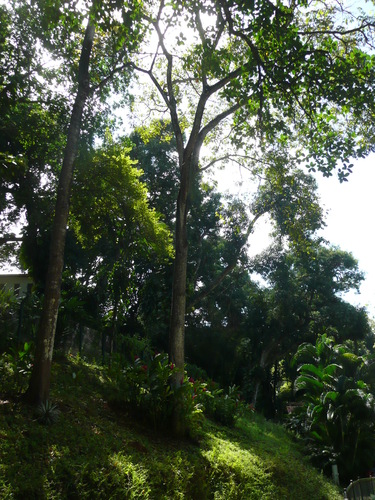
画像出典: http://www.panoramio.com/photo/12997457
[画像2] C.ダーウィンが行った時のバイア..
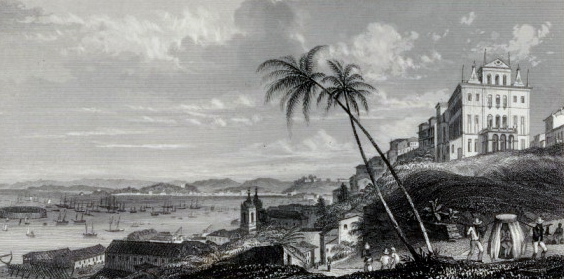
[天候: Capt.R.FitzRoy]
1836年8月2日午前9時の天候:
南南東の風、風力4、青空、雲、気温摂氏23.9度。
アーカイヴ記事: C.ダーウィンがビーグル号に乗って間もない1832年2月28日にはじめてバイア(サルバドル)に到着したときの日記記事..
http://saltyfumi.blog.so-net.ne.jp/1832-02-26
[日記原文]
August 1st
Anchored in Bahia de todos los Santos.
The first aspect of the city & its outskirts, with the beauties of which we were formerly so much delighted, had lost part of its charms. The novelty & surprise were gone, & perhaps our memories had, in the long interval, exaggerated the colours of the scenery. There existed, however, as we afterwards discovered, a more true reason, in the loss of some of the finest Mango trees, which during the late disturbances of the negroes had been cut down.
We staid here four days, in which time I took several long walks. I was glad to find my enjoyment of tropical scenery, from the loss of novelty, had not decreased even in the slightest degree.1 — The elements of the scenery are so simple, that they are worth mentioning as a proof on what trifling circumstances exquisite natural beauty depends.
The country may be described as a quite level plain of about three hundred feet elevation which has been in every part worn into flat-bottomed valleys. This structure is remarkable in a granitic land, but it is nearly universal in all those softer formations, of which plains usually are composed. The whole surface is covered by various kinds of stately trees, interspersed with patches of cultivated ground, amidst which stand houses, convents & Chapels. —
It must be remembered that within the tropics, the wild luxuriance of nature is not lost, even in the vicinity of large cities; the natural vegetation of the hedges & hill sides overpowers in picturesque effect, the artificial labor of man. Hence in but few parts, the bright red soil affords a strong contrast to the universal clothing of green. From the edges of the plain there are distant glimpses either of the ocean or of the great bay, bordered by low wooded shores, & on the surface of which numerous boats & canoes show their white sails.
Excepting from these points, the range of vision is very limited; following the level pathways, on each hand alternate peeps into the wooded valleys below can alone be obtained. Lastly I must add, that the houses & especially the sacred edifices are built in a peculiar & rather fantastic style of architecture. They are all white-washed, so that when illuminated by the brilliant sun of midday & as seen against the pale blue sky of the horizon, they stand out more like shadows than substantial buildings.
Such are the elements, but to paint their effects is an hopeless endeavour. — Learned naturalists describe these scenes of the Tropics by naming a multitude of objects & mentioning some characteristic feature of each. To a learned traveller, this possibly may communicate some definite ideas; but who else from seeing a plant in an herbarium can imagine its appearance when growing in its native soil? Who, from seeing choice plants in a hot house, can multiply some into the dimensions of forest trees, or crowd others into an entangled mass? Who, when examining in a cabinet the gay butterflies, or singular Cicadas, will associate with these objects the ceaseless harsh music of the latter, or the lazy flight of the former — the sure accompaniments of the still glowing noon day of the Tropics — It is at these times, when the sun has attained its greatest height, that such views should be beheld. Then the dense splendid foliage of the Mango hides the ground with its darkest shade, whilst its upper branches are rendered the more brilliant by the profusion of light. In the temperate zones, as it appears to me, the case is different, the colours there are not so dark, or rich, & hence the declining sun, which casts forth red, purple or yellow rays, is best adapted to add beauties to the scenery of those climes. —
When quietly walking along the shady pathways & admiring each successive view, one wishes to find language to express ones ideas: epithet after epithet is found too weak to convey to those who have not had an opportunity of experiencing these sensations, a true picture of the mind. — I have said the plants in a hot-house fail to communicate a just idea of the vegetation, Yet I must recur to it: the land is one great wild, untidy, luxuriant hot house, which nature made for her menagerie, but man has taken possession of it, & has studded it with gay houses & formal gardens. — How great would be the desire in every admirer of nature to behold, if such was possible, another planet; yet at the distance of a few degrees from his native country, it may be truly said, the glories of another world are open to him. —
In the last walk I took, I stopped again and again to gaze on such beauties, & tried to fix for ever in my mind, an impression which at the time I knew must sooner or later fade away. The forms of the Orange tree, the Cocoa nut, the Palms, the Mango, the Banana, will remain clear & separate, but the thousand beauties which unite them all into one perfect scene, must perish: yet they will leave, like a tale heard in childhood, a picture full of indistinct, but most beautiful figures.
1 Followed by a deleted sentence: 'I can truly say that I have never in my life relished a keener pleasure, than whilst gazing on some of these charming views.'

ここで扱うのは私の以前書いていたブログ "ダーウィンの日記(III)"
[特に http://saltyvoyage.blog.so-net.ne.jp/1836-01-12 以降]
からの再録になります。ただし、訳文や付加する地図などに対して、改良を加えてます。
冒頭画像出典: http://www.panoramio.com/photo/29448
C.ダーウィンの日記(1836年7月23日) [ダーウィンが行く(後半)]
ダーウィンの日記(大西洋; アセンションからブラジル、バイアへ)
[日記訳]
(1836年7月)23日
午後、外洋に出た。沖に向かうにあたって、船首は西南西航路へと進められ、これは英国に向かうことを切望している船上の者にとって辛い当惑と驚愕の事態であった[注]。 私は南アメリカの海岸を再び見る事になるとは思ってもみなかった。だが、運命が私たちをブラジルのバイア[*注]に向かわせているということには喜びを覚える。
[注] ダーウィンはビーグル号がアセンションからは英国へ進むものと思っていたらしい。これによると、アセンションから出発するまでは次の目的地がどこかは告げられていなかった模様。
[*注] ブラジル東部のサルバドル。地図2参照。
[地図1] アセンションの大域的位置..
View Larger Map
[地図2] サルバドル(バイア、ブラジル)..
View Larger Map
[天候: Capt.R.Fitzroy]
1836年7月23日正午の天候(アセンション):
南東の風、風力5、青空、雲、スコール、気温摂氏23.9度、水温摂氏23.9度。
[日記原文]
23rd
In the afternoon put to sea. — When in the offing, the Ships head was directed in W.S.W. course — a sore discomfiture & surprise to those on board who were most anxious to reach England. I did not think again to see the coast of S. America; but I am glad our fate has directed us to Bahia in Brazil. —

C.ダーウィンの日記(1836年7月21日と22日) [ダーウィンが行く(後半)]
"大洋は怒れる怪物なのだ。彼を千マイル離れたところで侮辱してみたまえ。するとその体は怒りにかき乱され地球の半球にまでも及ぶのである”.. C.ダーウィン; 大西洋のアセンション島での日記から
C.ダーウィンの日記(大西洋; アセンション)
[日記訳]
(1836年7月)21日と22日
続く2日間、私は長い散歩をしていくつかの火山岩の鉱物組成におけるかなり興味深い諸点を調べた。このためにエヴァンズ中尉[注]に案内をしてもらった。
[注] Lieut. Evans. アセンションに駐屯していた海兵隊の士官。
一日私は島の南西端まで歩いた。 天気は晴れて暑く、島が美しさで微笑んでいるとは私には見えず、むしろむき出しのひどさで睨めつけているように感じられた。 溶岩流は小丘で覆われていて地質学的に説明が容易ではない程度までに起伏が激しい。あいだにある箇所は軽石、火山灰、および火山性砂岩で埋められている。いくつかの場所では丸まった火山弾が、火口から赤く熱く噴出された時にこの形になったに違いないのだが、地表にまき散らされてある。
海上において島のこの端点を通った時には、私は平地全体が斑となっている白いぶちの理由を想像出来なかった。今や私はこれが数多くの海鳥によるのだということが分かった。彼らはすっかり安心して眠るので、昼間に人が近寄って捕えてしまうことを許すほどである。これらの鳥が私がこの日見た唯一の生き物であった[注]。
[注] 下の画像2参照。
海岸では大波が、風はそよ風だったが、ぼろぼろの溶岩の上に巻き下っていた。 大洋は怒れる怪物なのだ。彼を千マイル離れたところで侮辱してみたまえ。するとその体は怒りにかき乱され地球の半球にまでも及ぶのである。
[地図] アセンションの大域的位置..
View Larger Map
[天候: Capt.R.FitzRoy]
1836年7月22日午前9時の天候:
南東の風、風力4、青空、雲、スコール、気温摂氏23.3度、(水温摂氏24.1度)。
[画像1]
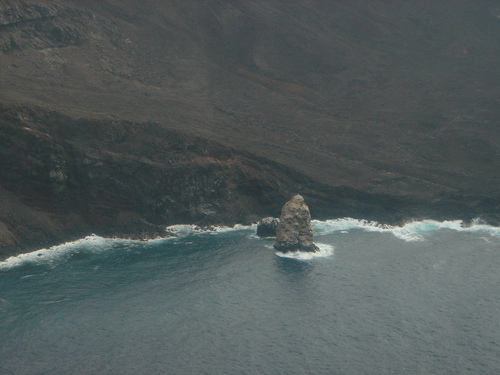
画像出典: http://www.panoramio.com/photo/6815967
[画像2] アセンション南西端沿岸の海鳥
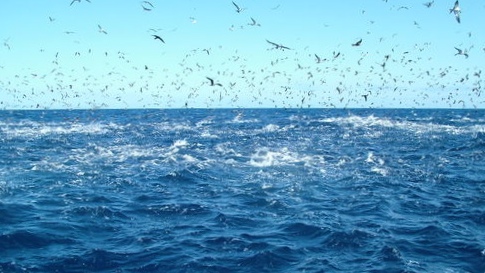
冒頭画像出典: http://www.panoramio.com/photo/4234734
[日記原文]
21st & 22nd
On the two succeeding days I took long walks & examined some rather curious points in the mineralogical composition of some of the Volcanic rocks, to which I was guided by the kindness of Lieut. Evans.
One day I walked to the SW extremity of the Isld: the day was clear & hot, & I saw the Island not smiling with beauty, but staring with naked hideousness. —
The lava streams are covered with hummocks, & are rugged to a degree which geologically speaking is not of easy explanation. The intervening spaces are concealed with layers of pumice, ashes, & volcanic sandstone. In some parts, rounded volcanic bombs, which must have assumed this form when projected red hot from the crater, lie strewed on the surface.
When passing this end of the Isld at sea, I could not imagine the cause of the white patches, with which the whole plain was mottled: I now found out it was owing to the number of seafowl, which sleep in such full confidence, as even in midday to allow a man to walk up to & seize hold of them. These birds were the only living creatures I this day saw.
On the beach a great sea, although the breeze was light, was tumbling over the broken lava rocks. — The ocean is a raging monster, insult him a thousand miles distant, & his great carcase is stirred with anger through half an hemisphere. —

ここで扱うのは私の以前書いていたブログ "ダーウィンの日記(III)"
[特に http://saltyvoyage.blog.so-net.ne.jp/1836-7-21 以降]
からの再録になります。ただし、訳文や付加する地図などに対して、改良を加えてます。
C.ダーウィンの日記(大西洋; アセンション)
[日記訳]
(1836年7月)21日と22日
続く2日間、私は長い散歩をしていくつかの火山岩の鉱物組成におけるかなり興味深い諸点を調べた。このためにエヴァンズ中尉[注]に案内をしてもらった。
[注] Lieut. Evans. アセンションに駐屯していた海兵隊の士官。
一日私は島の南西端まで歩いた。 天気は晴れて暑く、島が美しさで微笑んでいるとは私には見えず、むしろむき出しのひどさで睨めつけているように感じられた。 溶岩流は小丘で覆われていて地質学的に説明が容易ではない程度までに起伏が激しい。あいだにある箇所は軽石、火山灰、および火山性砂岩で埋められている。いくつかの場所では丸まった火山弾が、火口から赤く熱く噴出された時にこの形になったに違いないのだが、地表にまき散らされてある。
海上において島のこの端点を通った時には、私は平地全体が斑となっている白いぶちの理由を想像出来なかった。今や私はこれが数多くの海鳥によるのだということが分かった。彼らはすっかり安心して眠るので、昼間に人が近寄って捕えてしまうことを許すほどである。これらの鳥が私がこの日見た唯一の生き物であった[注]。
[注] 下の画像2参照。
海岸では大波が、風はそよ風だったが、ぼろぼろの溶岩の上に巻き下っていた。 大洋は怒れる怪物なのだ。彼を千マイル離れたところで侮辱してみたまえ。するとその体は怒りにかき乱され地球の半球にまでも及ぶのである。
[地図] アセンションの大域的位置..
View Larger Map
[天候: Capt.R.FitzRoy]
1836年7月22日午前9時の天候:
南東の風、風力4、青空、雲、スコール、気温摂氏23.3度、(水温摂氏24.1度)。
[画像1]

画像出典: http://www.panoramio.com/photo/6815967
[画像2] アセンション南西端沿岸の海鳥

冒頭画像出典: http://www.panoramio.com/photo/4234734
[日記原文]
21st & 22nd
On the two succeeding days I took long walks & examined some rather curious points in the mineralogical composition of some of the Volcanic rocks, to which I was guided by the kindness of Lieut. Evans.
One day I walked to the SW extremity of the Isld: the day was clear & hot, & I saw the Island not smiling with beauty, but staring with naked hideousness. —
The lava streams are covered with hummocks, & are rugged to a degree which geologically speaking is not of easy explanation. The intervening spaces are concealed with layers of pumice, ashes, & volcanic sandstone. In some parts, rounded volcanic bombs, which must have assumed this form when projected red hot from the crater, lie strewed on the surface.
When passing this end of the Isld at sea, I could not imagine the cause of the white patches, with which the whole plain was mottled: I now found out it was owing to the number of seafowl, which sleep in such full confidence, as even in midday to allow a man to walk up to & seize hold of them. These birds were the only living creatures I this day saw.
On the beach a great sea, although the breeze was light, was tumbling over the broken lava rocks. — The ocean is a raging monster, insult him a thousand miles distant, & his great carcase is stirred with anger through half an hemisphere. —

ここで扱うのは私の以前書いていたブログ "ダーウィンの日記(III)"
[特に http://saltyvoyage.blog.so-net.ne.jp/1836-7-21 以降]
からの再録になります。ただし、訳文や付加する地図などに対して、改良を加えてます。



